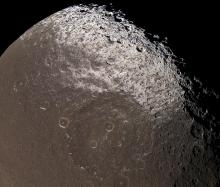Listen to today's episode of StarDate on the web the same day it airs in high-quality streaming audio without any extra ads or announcements. Choose a $8 one-month pass, or listen every day for a year for just $30.
You are here
Moon and Saturn
Saturn’s moons and rings have a complicated relationship. Some of the moons act as shepherds, keeping the ring particles in line. Other moons supply some of the material that makes up the rings. At the same time, bits of ice and dust from the rings coat some of the moons.
Earlier this year, in fact, scientists reported evidence that ring material is coating five small moons. All of the moons are near the outer edge of the main bands of rings.
The two of the moons that are closest to Saturn appear to have a fluffy coating with a slightly reddish color. The coating probably consists of particles of dust from the nearby rings, which are also slightly red. The coatings have built up around the moons’ equators, so the moons are elongated instead of round.
The three other moons are a little farther from Saturn — just beyond the outer edge of the rings. They look blue and icy. That suggests they are coated with ice from another moon, Enceladus. Geysers of water and ice shoot out from its south pole. The ice forms a thin outer ring around Saturn. But some of it drops toward the planet. The ice can add to the main rings, fall into Saturn’s atmosphere — or add a frosty coating to Saturn’s other moons.
Saturn appears near our own moon tonight. It’s just a whisker above the Moon as they climb into view in late evening. The giant planet looks like a bright star. It’ll be a little farther to the right of the Moon at first light tomorrow.
Script by Damond Benningfield






